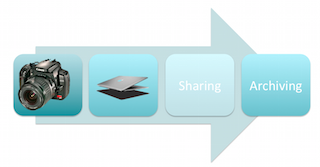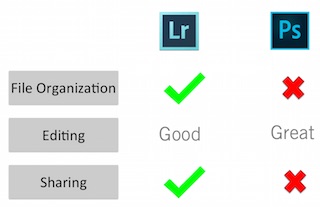Photoshop vs Lightroom

Adobe Photoshop vs. Lightroom
In this day and age, it’s almost impossible to escape the term “Photoshopped.” As a photographer, knowing how to use Photoshop--or at least, knowing what the program can do--seems to be an imperative qualification. However, what many people don’t realize is that Adobe, the software company behind Photoshop, actually offers an alternative to Photoshop that is just as useful--Lightroom. As if Photoshop alone weren’t intimidating enough to understand, now you need to learn which of these two programs will serve you best. Don’t worry--we’re here to help simplify your selection.
What is a digital workflow?
Before we look at each program individually, it’s important to discuss something known as digital workflow. Simply put, a digital workflow is a system you create for managing your digital images, from taking the picture in your camera, to printing your photograph or uploading it online. Think of your digital workflow as a way of organizing your images. How you organize is all up to you. It’s important to understand that every photographer tends to develop a personalized workflow. What works best for me, may not necessarily work well for you.

What is Photoshop?
Photoshop began as an image editing software program meant to replicate some of the processes photographers used in the traditional darkroom. Over time, the brains behind Adobe realized that many different professions could benefit from this software, from graphic designers to architects. The result is an uber-powerful program that has myriad features and capabilities. If you can dream up a way to alter an image, you can probably execute it in Photoshop. The potential is nearly unlimited--but this is also what makes the program intimidating or unwieldy for beginners.
What is Lightroom?
Lightroom, on the other hand, is designed to be a way to sort through and manage all your digital images. Think of it as a catalog of your work--in fact, Lightroom will actually create something known as your image “catalog.” This allows you to sort photos by a variety of different criteria, be it the date photograph was shot, the rating you assign to the image, or who or what is in the picture. If this sounds like simply a glorified photo album, think again--Adobe did add a number of useful post-processing (editing) tools into Lightroom, tailored specifically to photographers’ needs.
Main Differences Between Photoshop & Lightroom
A good way to understand the main differences between the two programs is to consider the digital workflow described above. Lightroom can handle every step that takes place on your computer. Photoshop, on the other hand, can really only excel at the post-processing step--albeit in a much more in-depth way than Lightroom can. For example, in Lightroom, you can make a number of adjustments to your photos, like changing the brightness of the image, crop, remove some imperfections such as lens flares, convert to black and white, and improve colors. What you can’t do easily is edit out skin blemishes on your subject’s face, create composites by blending together several images, or completely remove unwanted elements from your image. This is where Photoshop comes in handy. With Photoshop, you can even do things like add artistic filters to your photos, making them seem like paintings, or design a business card. This is where the strengths of Photoshop really shine--where photography and graphic design intersect.

Which program is right for me?
Lightroom is great if you’re a photographer who struggles with managing hundreds, or even thousands, of images, which only need some basic fixes. It can help you download your photos, organize them, edit them a bit, and export them for printing or online publication. Photoshop lacks several of these features--which makes it primarily a post-processing or retouching program. If you’re more interested in making radical changes to your images in the post-processing phase, or if you may also do some graphic design-oriented work, Photoshop will be a better choice. If you want the best of all possible worlds--and have the budget to splurge for it--Lightroom and Photoshop really act as perfect complements to one another.
Comments
Sign in to comment.